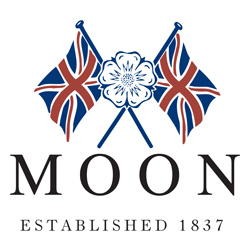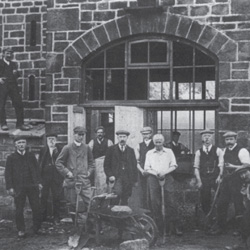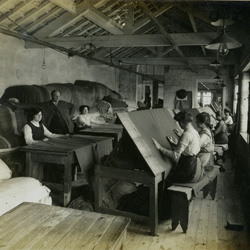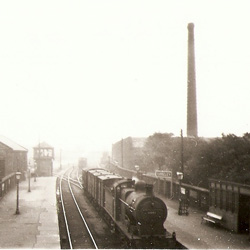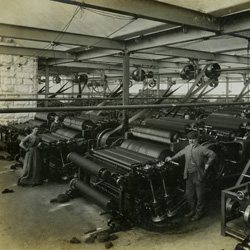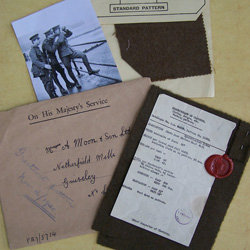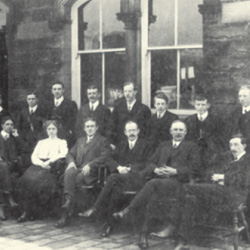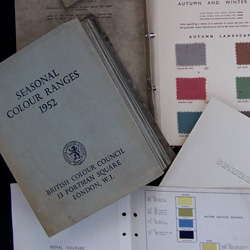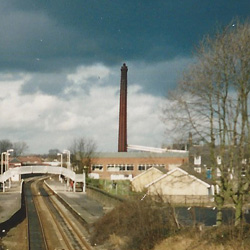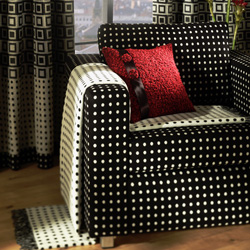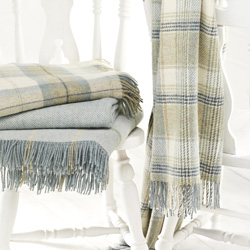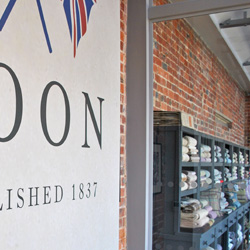Abraham Moon:
Engelse stoffen voor het laten maken van een pak, colbert en broek.
Founded in 1837 and with our roots in apparel, we are one of the last remaining vertical woollen mills in Great Britain, with a reputation for consistent quality and innovative design. Here you can discover more about the Abraham Moon mill, our illustrious company history, and the many natural benefits of wool fabrics.
Our company's fine history is just one of many features that come together to make Abraham Moon products extra special, and is something we're rightfully proud of. From supplying fabric for a growing Leeds market throughout the 1800's to supplying the major fashion houses of modern times, this rich tapestry all comes together to create quite a story over the past 180 years.
Menswear Heritage Stories
AIRFORCE BLUE
Airforce Blue is a medium shade of the colour azure. This shade gets its name from the medium blue-grey colour associated with the Royal Air Force and other air forces which use the colour to mark out their particular service identity.
BARATHEA
Barathea is an expensive fine English cloth, closely woven with a slight diagonal weave appearance and broken rib effect. It has a granular or pebbled surface but it feels smooth to the touch. Mainly used as a suiting or uniform fabric and it can also be used in men’s evening clothes.
BLAZER STRIPES
The first “blazers” were worn by student members of the Lady Margaret boat club at Cambridge. Joking reference to a “blaze of colour” was also applied to brightly striped boating jackets worn by English University cricket, tennis and rowing teams during the 1880’s.
BRITISH ARMY GREATCOAT
A greatcoat is a large overcoat designed for warmth and protection against the elements. Normally made of wool the dense, felted construction is naturally water resistant. Popular in the 19th century as a military uniform, it has been issued, for inclement weather, by most armed forces right up until the last quarter of the 20th century.
BRITISH RED COAT
Warriors of ancient Sparta wore expensive red cloaks and this colour was adopted as the only colour on which the spilled blood of enemies would not leave stains. The British red coat actually originated as an historical accident, probably due to the cheapness of madder red dyes at the time of the English Civil war.
CAVALRY TWILL
A smooth surfaced twill fabric with a clean steep prominent double twill effect. Traditionally a fine wool worsted fabric, or combination of worsted warp and woollen weft, it was used for hard wearing clothes such as riding breeches – hence the association with British Cavalry officers.
COVERT
A covert coat is a light, knee length, shower-proof topcoat in Venetian (steep) twill. Often olive or stone in colour, with a toning velvet collar and rows of stitching at the sleeve, cuff and hem. The name derives from an English word meaning “a thicket hiding game” and was originally worn when riding.
DONEGAL
Donegal Tweed is a generic term for loose Irish tweed of speckled appearance. Famous for its warmth and durability, its name is taken from the county of Donegal in Ireland. Woven from woollen spun yarns, it is characterised by its plain weave structure composed of uneven slub yarns contrasting with the ground colour. Kilcarra Donegal yarn is the only genuine Donegal yarn spun in Ireland.
DUFFEL COAT
A coarse, thick woollen coat which derives its name from Duffel, a town in the province of Antwerp in Belgium, where the material originates. Duffel coats are a traditional British garment dating from 1890 and it owes its popularity to the British Royal Navy who issued a camel coloured variant as an item of warm clothing during World War I.
ESTATE TWEED
Like tartans, estate tweeds are an internationally appreciated innovation. However, whilst tartans are associated with Scottish families and clans, District Checks evolved as liveries to identify the people who worked and lived on the same Scottish estates. It became fashionable for owners and retainers to dress in the same pattern of tweed.
FLANNEL
The word flannel may be derived from the Welsh word “gwalnen” meaning woollen cloth. Flannel was originally made as a heavy, comfortable, soft and slightly napped wool cloth. Popular in the 1920’s, flannel trousers were traditionally worn in warmer weather with grey being the most popular colour, thus grey flannel pants were called “greyers”
HUNTING PINK
Not pink but scarlet. Originally all hunting rights belonged to the king and those taking part often wore the King’s livery, which was often scarlet. The tradition has lived on in riding coats everywhere. The origins of “pink” are not clear; theories of the colour of a weathered scarlet coat or the name of a famous tailor are often cited.
MELTON
A densely woven, heavy over coating, with a short non-directional nap, originating from the town of Melton Mowbray in the heart of the East Midlands. Milling the fabric to make it compact, then raising and cropping the surface nap, hides the weave – usually a simple twill – from view. This fabric was manufactured to exacting British Standards and specified for local authority services, the Fire Service, the Post Office and the British Railways Board.
PRINCE OF WALES CHECK
Designed by his King Edward VII when he was Prince of Wales, as livery for his hunts at Abergeldie Castle on Scotland’s Deeside it was popularised by his grandson the Duke of Windsor when he was Prince of Wales. Its authentic colours are red-brown on a white ground with a slate grey overcheck.
SHEPHERD CHECK
In the 15th Century, shepherds often wore long pieces of cloth, called plaid, to protect themselves from the elements. The cloth was woven from the un-dyed wool of the black and white sheep they herded. Sometimes called a dogtooth or gunclub check, historians believe this black and white shepherd check the first plaid ever designed
SHETLAND
The Shetland Sheep are the smallest of their species and are believed to have evolved from north European sheep brought to the island by the Vikings. Historically Shetland Wool is long stapled with some softer undercoat, with the coarser fibres of the topcoat lending themselves to intricate colour melanges. Today the term is used for tweeds similar to Harris Tweed but with a softer handle.
TARTAN
Colourful check designs, adopted in Scotland by Highland clans and families, as a means of identification. In 1538 James V of Scotland called for an order of “tertane”, which was likely, the basic black & white or brown & cream checks that lowland shepherds wove from the wool of their sheep. Tartan cloth is woollen or worsted in twill weave. The traditional garment is the pleated kilt, but is also now used for trousers, shawls, scarves and other fashion garments.
TATTERSALL
Against a white ground, offset checks of red and black are laid in even squares – though there are modern colour variations. Derived from a man who lived in Tatt’s Hall in Lincolnshire and then from the colourful checked waistcoats worn by the racing fraternity at Tattersall’s horse market.
TWEED
The word “tweed” is an English variant of the Scottish word “Tweel” which refers to a rough unfinished hand woven fabric. The name became associated with the Tweed River which forms part of the boundary between England and Scotland. Nowadays the name became a general term for all carded “homespun” wool whether it was Scotch, Irish, Donegal, Cheviot or Harris Tweed. Our British Tweed uses British Wool with subdued colour effects (heather mixes) to continue this tradition.
THORNPROOF
A characteristic tweed with a salt & pepper colouring style. Normal tweeds are woven from single yarns, but Thornproof tweed is made from 2-fold twisted yarns producing a durable and impenetrable cloth – hence “thorn-proof”.
CHALK & PINSTRIPES
The 1930’s saw dramatic changes in men’s fashion. In the early part of the decade suits were modified to create the image of a larger torso to enhance masculine elegance and a striped suit became a standard in every man’s wardrobe. These suits appeared in charcoal, steel and mixtures of grey, slate, navy and midnight blue.
THE OVERCOAT
An overcoat is a type of long coat intended to be worn as the outermost garment. Overcoats usually extend below the knee, but are sometimes mistakenly referred to as topcoats, which are in fact short coats that end at or above the knees. Overcoats are made from heavier cloth or fur, because overcoats are more commonly used in winter when warmth is more important.
HACKING JACKET
The Hacking Jacket evolved from the riding coats worn since the 18th Century by country folk. It has a unique personality to it and its traits are as truly British as can be. Its story is one of singular importance to the larger history of English clothing. The name is derived from `hacking` which is the term for informal or pleasure riding. It is an accentuated version of a sports jacket with a snugger fit and tighter waist.
WORSTED SPORT JACKET
Although of a similar cut and length to a traditional suit jacket, the sport jacket has a softer construction and may be worn on less formal occasions. Colours and patterns are more varied and usually incorporate designs such as glen-check or gun-plaid.
BRITISH WOOL TWEED
When the Romans invaded in 55BC, the Britons already had a developed wool industry. By the 8th century, woollen fabrics were being shipped to the continent, quickly becoming Britain’s biggest export. British wool is coarser quality wool which makes it hard wearing; it should not be regarded as inferior to fine wool, merely different and ideal for stylish outerwear.
PEACOAT
A Pea Coat is an outer coat of heavy wool, originally worn by sailors of European, and then later, American navies. Pea coats are characterised by broad lapels, double breasted fronts and often large wooden or metal buttons. They have vertical or slash pockets, with modern renditions still maintaining these original design features.
DOUBLE CLOTH
Double cloth is a compound woven structure in which two or more sets of warps and one or more sets of wefts are interlaced to form a two layer cloth. Double cloth fabrics have two right sides and no ‘wrong side’; contemporary designers use true double cloth to make self-lined or reversible coats and jackets.
Ladieswear Heritage Stories
BLACK AND WHITE
Black and White come from opposite ends of the colour spectrum, so when used together they create a high amount of visual contrast. They give elegance and set a sophisticated and timeless tone.
BLAZER STRIPES
The first “blazers” were worn by student members of the Lady Margaret boat club at Cambridge. Joking reference to a “blaze of colour” was also applied to brightly striped boating jackets worn by English University cricket, tennis and rowing teams during the 1880’s.
BOILED WOOL
Boiled Wool is created from a woven fabric that has been shrunk and thickened using an ancient process known as ‘Fulling’ or ‘Felting’. Wool that has been boiled is thought to produce a fabric that is warmer, more durable, windproof and highly water resistant.
1960's BOUCLE
In the 1960’s, every well dressed woman wanted to copy the classy look of Jackie Kennedy. To do this you needed boucle fabric in a variety of pastel colours. Boucle is a yarn with a length of loops of similar size. One strand is looser than the other so as it is plied, the loose strand forms a loop.
BRITISH WOOL TWEED
When the Romans invaded in 55BC, the Britons already had a developed wool industry. By the 8th century, woollen fabrics were being shipped to the continent, quickly becoming Britain’s biggest export. British wool is coarser quality wool which makes it hard wearing; it should not be regarded as inferior to fine wool, merely different and ideal for stylish outerwear.
CAVALRY TWILL
A smooth surfaced twill fabric with a clean steep prominent double twill effect. Traditionally a fine wool worsted fabric, or combination of worsted warp and woollen weft, it was used for hardwearing clothes such as riding breeches – hence the association with British Cavalry officers.
COUTURE TWEED
Coco Chanel is credited with bringing tweed to high fashion. In 1926 she introduced a tweed version of her signature cardigan jacket containing a mixture of fibres to give it a textured appearance. Chanel tweed suits of the 1950’s were the uniform of elite high society women all over the world.
DONEGAL
Donegal Tweed is a generic term for loose Irish tweed of speckled appearance. Famous for its warmth and durability, its name is taken from the county of Donegal in Ireland. Woven from woollen spun yarns, it is characterised by its plain weave structure composed of uneven slub yarns contrasting with the ground colour. Kilcarra Donegal yarn is the only genuine Donegal yarn still spun in Ireland.
DOUBLE CLOTH
Double cloth is a compound woven structure in which two or more sets of warps and one or more sets of wefts are interlaced to form a two layer cloth. Double cloth fabrics have two right sides and no ‘wrong side’; contemporary designers use true double cloth to make self-lined or reversible coats and jackets.
GEOMETRIC
Closely linked to the British music taste of the time, the mod look of the 1960s popularised the simple geometric shapes that became so typical of the decade. Heals, Hull Traders and Conran Fabrics all bought patterns from young freelance designers who took their inspiration from art and graphics of Andy Warhol’s Pop images and the Op Art paintings of Bridget Riley.
HACKING JACKET
The Hacking jacket evolved from the riding coats worn since the 18th century by country folk and which caught the attention of the country loving English aristocracy. The hacking jacket is an accentuated version of a sports jacket, with a snugger fit and tighter waist; its traits are as truly British as can be.
HUNTING PINK
Not pink but scarlet. Originally all hunting rights belonged to the king and those taking part often wore the King’s livery, which was often scarlet. The tradition has lived on in riding coats everywhere. The origins of “pink” are not clear; theories of the colour of a weathered scarlet coat or the name of a famous tailor are often sited.
MOHAIR
Mohair, from the Angora goat, is one of the oldest fibres in use, and is notable for its high lustre and sheen. In about 1820, raw mohair was first exported to England, which then became the leading manufacturer of mohair products. Yorkshire mills spun yarn that was exported to Russia, Germany & Austria as well as being woven directly into cloth in Yorkshire.
PEA COAT
A Pea Coat is an outer coat of heavy wool, originally worn by sailors of European, and then later, American navies. Pea coats are characterised by broad lapels, double breasted fronts and often large wooden or metal buttons. They have vertical or slash pockets, with modern renditions still maintaining these original design features.
SHETLAND
The Shetland Sheep are the smallest of their species and are believed to have evolved from north European sheep brought to the island by the Vikings. Historically Shetland Wool is long stapled with some softer undercoat, with the coarser fibres of the topcoat lending themselves to intricate colour melanges. Today the term is used for tweeds similar to Harris Tweed but with a softer handle.
STRETCH
Elastane is a synthetic fibre known for its exceptional elasticity. Invented in 1937, but not commercialised as a fibre until 1959, it revolutionised the clothing industry by enabling garments to not only fit well, but make them more comfortable to wear as they flexed with the movement of the body.
TARTAN
Tartans are colourful check designs adopted in Scotland as means of identification by various Highland clans as well as families and sects under their protection. Tartan cloth is woollen or worsted in twill weave. The traditional garment is the pleated kilt, but it is also now used for trousers, shawls, scarves and fashion garments.
TROUSER SUIT
The Trouser Suit was introduced in the 1920s, when a small number of women adopted a more masculine fashion style, including trousers, hats and even canes and monocles. In the early 1960s, French designer, Andre Courreges introduced slim tapering trousers for women as a fashion item, promoting them for everyday and smart wear.
TWEED COAT
The word “tweed” is an English variant of the Scottish word “Tweel” which refers to a rough unfinished hand woven fabric. The name became associated with the Tweed River which forms part of the boundary between England and Scotland. The name became a general term for all carded “homespun” wool whether it was Scotch, Irish, Donegal, Cheviot or Harris Tweed.
UTILITY CLOTHING
During wartime, fashion was largely determined by necessity and availability; fabric manufacturers, like Moon, concentrated mainly on war-related textiles, with wool being in demand for manufacturing uniforms. The Utility Scheme was introduced making sure goods were produced at reasonable prices and high standards, whilst also meeting the restrictions on raw materials.
